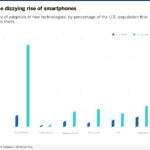Are new gadgets threatening the reign of smartphones?
E-everything: Smart cars, watches and speakers have all begun to earn a place in the everyday lives of millions of people. Could any of them become as important as smartphones?

Does anyone remember PDAs? Most children have likely never even heard of them. PDA stands for Personal Digital Assistant. These devices became very popular around 2000, and in one way or another, were the precursors to smartphones and were an enormous success. The leading PDA brands such as Palm, were object of large corporate transaction. Today, however, they have disappeared, made obsolete by smartphones.
The pace of innovation is dizzying and has left behind many companies, despite how powerful they once seemed. The decline of Yahoo, MySpace and Blackberry are good examples. It’s not just about the companies, however. Technological gadgets must survive in a cruelly Darwinistic environment: the ones that fail to adapt to change will disappear or become irrelevant. There are no longer PDAs, video cameras are only for a select few, and CD players have become increasingly cumbersome in the living room.
Most of these changes have been caused by smartphones, which in the last ten years have become an essential tool in the daily lives of nearly 2.5 billion users, a pace of adoption never seen before with other technologies. Nevertheless, the consultant BI Intelligence recently published a study by analyst Laurie Beaver that asked whether smartphones will have a taste of their own medicine in the short-term future. Is there a gadget capable of replacing the smartphone in the digital day-to-day, or at least of threatening its dominance?

Beaver’s study focused on three specific gadgets that already have acquired certain commercial acceptance: smartwatches, connected cars and smart speakers. To compare their possibilities with those of the smartphone, the study asserts that the smartphone’s importance is due to four features: they have an extremely high penetration rate; users carry them on their person; they are the center of digital activity; and they have become essential. BI Intelligence also presented a survey which asked respondents how they feel when they leave their cell phone at home in the morning. Some 14% answered that their day is ruined at that point; 37% were willing to return home and look for their phone, while 15% were either happy or unconcerned about the matter.
So what’s the conclusion of the study? For researcher Laurie Beaver, the rule of the smartphone has ended: different alternatives will reduce the daily average use of cell phones by nearly four hours. However, in an environment where content will be available everywhere, smartphones will continue to dominate. In the short-term, no other device will be as omnipresent and important.
The smartwatch: intriguing, but not enough
According to Beaver’s analysis, the smartwatch has an important point in common with cell phones: users wear it almost all the time. A total of 68% of smartwatch owners use it every day, and up to 25% keep it when they sleep. In addition - again according to data provided by BI Intelligence -14% of users say that smartwatches are already making them use their smartphones less, thanks to some of the intelligent watch’s functions, such as checking email and looking up addresses.
However, the report’s conclusion is that smartwatches are not currently rivals for smartphones. They lack critical mass and they don't have as many functions as phones (smartwatches can’t make voice calls and don't provide access to communications media). Unlike the smartphone, the smartwatch doesn´t create a dependency among its users: 72% say that it doesn't matter if they leave it at home at the start of the day, a figure that drops to 11% for smartphones left behind.
The connected car: a good option, but only on when you're on wheels
The potential of the connected car is enormous. In the first place, because connected cars are expected to have enormous growth relatively soon: 100 million connected cars are currently estimated be in use around the planet and, according to predictions by PwC, that figure will rise to 470 million in 2025. Also, the automobile is a place where people spend lots of time every day (especially in the United States, where just commuting to work adds up to a daily average of 53 minutes, according to BI Intelligence). Unlike smartwatches, connected cars are an excellent environment in which to consume information and audiovisual content. In addition, they'll have a role in e-commerce by incorporating payment methods.
However, by definition, the car cannot be as omnipresent as the cell phone, because a car doesn’t go inside people's homes. It will steal time away from the smartphone, but only when the connected user is moving on four wheels.
Smart speakers: your home is your castle
Smart speakers are music playback systems that include a virtual assistant that can answer questions and control other home electronic devices through voice commands. In some ways, smart speakers such as Amazon Echo and Google Home—which have a combined 94% market share in the United States—are the sidekick to connected cars. While vehicles may become very important for consumers when they are outside, speakers will do so when users are at home. However, only the cell phone moves seamlessly through a person’s life entire life.
This isn't to say that smart speakers won’t become a top-notch apparatus. First of all, their penetration rate has seen spectacular growth. According to the voice applications company VoiceLabs, six million voice-first apparatuses were distributed in 2016, a figure that quadrupled, to 24 million in 2017. For its part, BI Intelligence estimates that in 2018, smart speakers will be present in 11% of US homes (15 million), and just six years later, in 47%. Smart speakers are already being used to consume media: 82% of owners use them to listen to music and 20%, to hear podcasts.